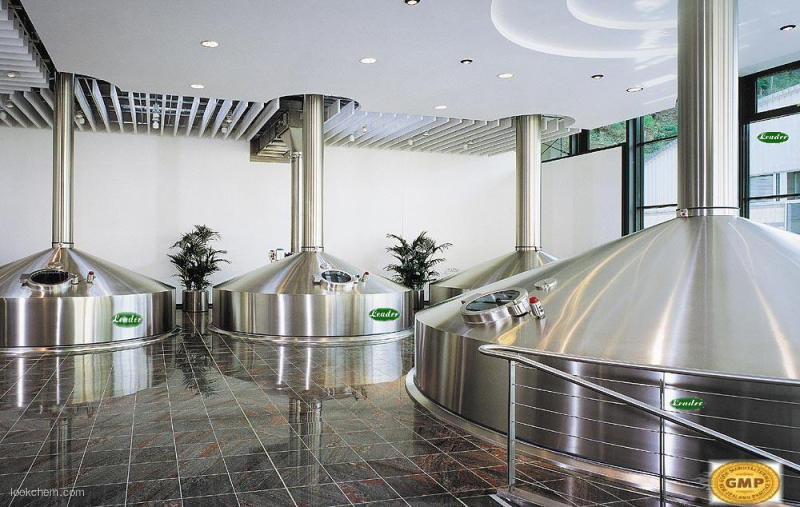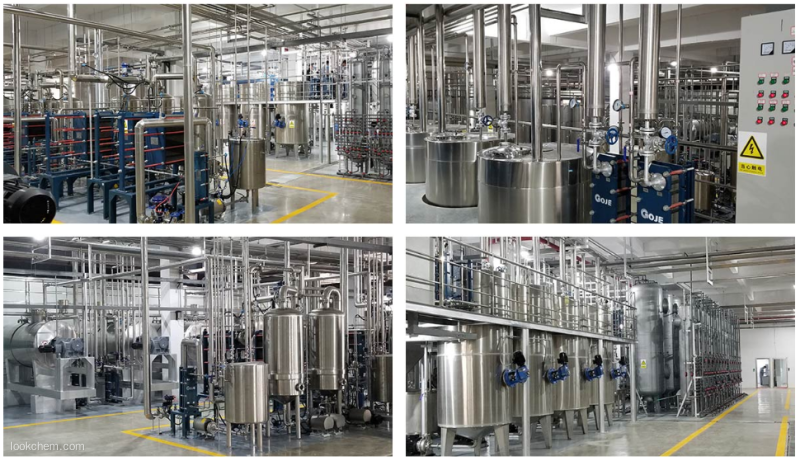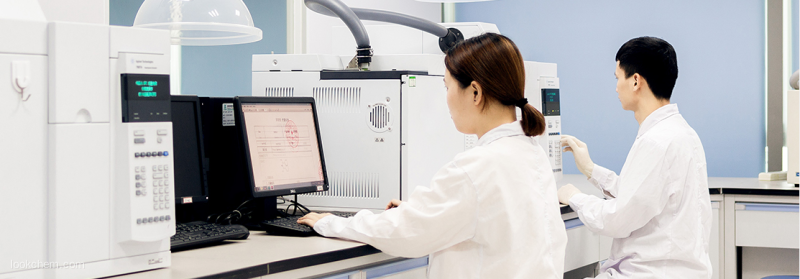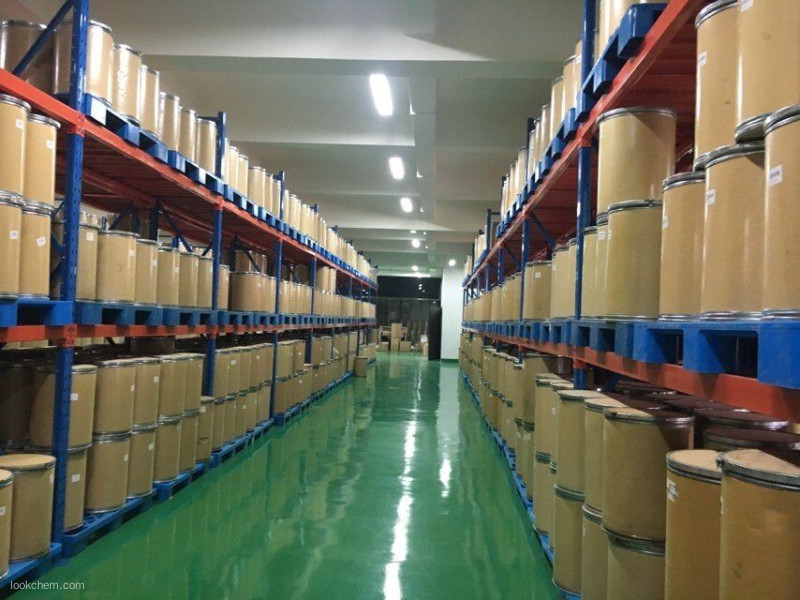PRODUCT DETAILS
| Product Name: |
ChicoricAcid |
| Synonyms: |
(2R,3R)-2,3-Bis[[3-(3,4-dihydroxyphenyl)-1-oxo-2-propenyl]oxy]butanedioic acid;(2R,3R)-2-O,3-O-Bis[3-(3,4-dihydroxyphenyl)acryloyl]tartaric acid;[2R,3R,(-)]-2,3-Bis[[3-(3,4-dihydroxyphenyl)-1-oxo-2-propenyl]oxy]butanedioic acid;2-O,3-O-Bis[3-(3,4-dihydroxyphenyl)propenoyl]-L-tartaric acid;Chicoric acid;Butanedioic acid, 2,3-bis((3-(3,4-dihydroxyphenyl)-1-oxo-2-propenyl)oxy)-, (R-(R*,R*))-;Dicaffeoyltartaric acid CICHORIENSAURE;Chicoric |
| CAS: |
6537-80-0 |
| MF: |
C22H18O12 |
| MW: |
474.37 |
| EINECS: |
|
| Product Categories: |
chemical reagent;pharmaceutical intermediate;Aromatic Phenols;phytochemical;reference standards from Chinese medicinal herbs (TCM).;standardized herbal extract |
| Mol File: |
6537-80-0.mol |
 |
| |
| ChicoricAcid Chemical Properties |
| Melting point |
200~208℃ |
| Boiling point |
785.0±60.0 °C(Predicted) |
| density |
1.641±0.06 g/cm3(Predicted) |
| storage temp. |
Sealed in dry,Store in freezer, under -20°C |
| solubility |
DMSO (Slightly), Methanol (Slightly), Pyridine (Slightly) |
| pka |
1.47±0.25(Predicted) |
| form |
Solid |
| color |
Pale Yellow |
| Stability: |
Hygroscopic |
| InChIKey |
YDDGKXBLOXEEMN-IABMMNSOSA-N |
| CAS DataBase Reference |
6537-80-0 |
| |
| ChicoricAcid Usage And Synthesis |
| Chicory extract |
Cicory acid is a water-soluble phenolic acid compound extracted from the dry whole grass of the Compositae.It is anti-inflammatory, can enhance immune function and induce cell apoptosis. It can also inhibit hyaluronidase and protect collagen from the free radical that can be degraded. |
| Plant origin |
Base source
The dry roots, stems, leaves and flowers of the Compositae.
Plant morphology
Perennial herb, 40~120 cm high, with a gray whiteplant. The root is hypertrophy.Stems are erect, prismatic and hollow. The branches are skewed and thick at the apex with sparsely coarse hair or sericite and rarely no hair case.The basal leaves and the lower leaves of the stem split in the form ofupside pinniform down to the whole, 5~11 cm long and 1~2 cm wide. Apex lobes are larger and lateral lobes are triangular. Basal part is gradually narrowed into winged petioles; Stem leaves are sessile and the leaves gradually become smaller witha small number. Lanceolate ovate to lanceolate and the upper leaves are small. Below all the leaves are sparsely coarse hair or sericite. For the capitulum inflorescence single stem and branch end, 2~3 will cluster in the upper middle axillary fascicles; Involucre is cylindrical, 8~14 mm long; The outer layer of the involucre is of different shapes and lengths. The length of the length is different. The lower part feels like soft leather with lashes and hairy or non-hairy outside. All the flowers are ligulate and the Corolla is blue. The apex of the achenes is truncated and pappus is short, shaping like Scale and the apex is finely toothed. The flowering period is from July to August, and the fruit period is September.
Habitat and distribution
It grows in the foot of the mountain wetland, the beach barren hills and other places. It is produced in Shenyang, Dalian and other cities.  Figure 1 Chicory Figure 1 Chicory |
| Stability |
- The effect of pH value on the stability of chicory acid
The effects of different pH on the stability of chicory are different. The degradation rate of chicory acid in strong acid environment is lower than that in weak alkali environment.
- The effect of temperature on the stability
The high temperature leads to the accelerated degradation of chicory acid, and the low temperature is beneficial to the stability of chicory.
- The effect of metal ions on the stability
Na+ and K+ did not react with chicory acid; But the reaction of chicory with CaCl2 solution is very rapid, and the mechanism of yellowing of the solution remains to be further explored.The complexity of the food system leads to the mixing of various metal ions. Other metal ions, such as Ca2+, may have a great effect on chicory acid. When chicory acid is applied to food, we should consider the effect of metal ions on chicory acid in liquid food environment or in the post-flush environment so as to avoid the reaction resulting in the degradation of chicory acid and the changes of food quality.
- Effect of UV on the stability of chicory acid
In methanol, chicory is more susceptible to ultraviolet light and isomerization into icricicory. The conversion rate of isomerization of chicory is higher because the polarity of methanol is smaller than that of water.When chicory is used in food, It should be taken into consideration that the sensitivity of chicory acidafter dissolving to ultraviolet light is higher. In the process, contact with ultraviolet light should be reduced.
- Study on its stability in fruit juice and beverage
The low temperature storage is more favorable to the stability of chicory than the room temperature. At room temperature (25 ℃), cicory acid 15d will be completely decomposed in the water solution, indicating that the beverage system could protect cicory from degradation to some extent. The juice and beverage system itself is very complex. It is indicated that 100 mg vitamin C is added to the system of 445mL, which has antioxidant effect and can protect chicory to a certain extent. Therefore, the concentration of chicory is still at a high level even for 3 months.
- Study on its stability in milk powder
Milk powder is a representative solid food environment. All the components in water activity is very small and relatively stable when isolated from air, water vapor and in light avoidance environment. This is for the lack of environmental factors that cause chicory acid degradation. Therefore, the concentration changes of chicory acid are not affected by the time and the milk powder system. In dry and room temperature storage, chicory can remain relatively stable in the milk powder system.
- Study on its stability in jelly
The jelly system itself is very stable, and its water activity is very small. Chicory can be kept stable for a long time when it is stored under such a relatively closed condition, isolated from oxygen and water vapor.The slight fluctuations in the detection data may be caused by the error of the sample processing. |
| Uses |
Chicoric Acid is an effective inhibitor of human immunodeficiency virus type-1 (HIV-1) integrase and the replication in tissues. Also a class of cannabinomimetics with CB2 receptor-dependent and indep endent |
| Uses |
Chicoric Acid is an effective inhibitor of human immunodeficiency virus type-1 (HIV-1) integrase and the replication in tissues. Also a class of cannabinomimetics with CB2 receptor-dependent and independent |
| |
| ChicoricAcid Preparation Products And Raw materials |
|
|
|
|
|
|
|
|
|
|
|
|
|
|
About US
Leader Biochemical Group is a large leader incorporated industry manufacturers and suppliers of advanced refined raw materials From the year of 1996 when our factory was put into production to year of 2020, our group has successively invested in more than 52 factories with shares and subordinates.We focus on manufacture Pharm & chemicals, functional active ingredients, nutritional Ingredients, health care products, cosmetics, pharmaceutical and refined feed, oil, natural plant ingredients industries to provide top quality of GMP standards products.All the invested factories' product lines cover API and intermediates, vitamins, amino acids, plant extracts, daily chemical products, cosmetics raw materials, nutrition and health care products, food additives, feed additives, essential oil products, fine chemical products and agricultural chemical raw materials And flavors and fragrances. Especially in the field of vitamins, amino acids, pharmaceutical raw materials and cosmetic raw materials, we have more than 20 years of production and sales experience. All products meet the requirements of high international export standards and have been recognized by customers all over the world. Our manufacture basement & R&D center located in National Aerospace Economic & Technical Development Zone Xi`an Shaanxi China. Now not only relying on self-cultivation and development as well as maintains good cooperative relations with many famous research institutes and universities in China. Now, we have closely cooperation with Shanghai Institute of Organic Chemistry of Chinese Academy of Science, Beijing Institute of Material Medical of Chinese Academy of Medical Science, China Pharmaceutical University, Zhejiang University. Closely cooperation with them not only integrating Science and technology resources, but also increasing the R&D speed and improving our R&D power. Offering Powerful Tech supporting Platform for group development. Keep serve the manufacture and the market as the R&D central task, focus on the technical research. Now there are 3 technology R & D platforms including biological extract, microorganism fermentation and chemical synthesis, and can independently research and develop kinds of difficult APIs and pharmaceutical intermediates. With the strong support of China State Institute of Pharmaceutical Industry (hereinafter short for CSIPI), earlier known as Shanghai Institute of Pharmaceutical Industry (SIPI), we have unique advantages in the R & D and industrialization of high-grade, precision and advanced products. Now our Group technical force is abundant, existing staff more that 1000 people, senior professional and technical staff accounted for more than 50% of the total number of employees, including 15 PhD research and development personnel, 5 master′ S degree in technical and management personnel 9 people. We have advanced equipment like fermentation equipment and technology also extraction, isolation, purification, synthesis with rich production experience and strict quality control system, According to the GMP required, quickly transforming the R&D results to industrial production in time, it is our advantages and our products are exported to North and South America, Europe, Middle East, Africa, and other five continents and scale the forefront in the nation, won good international reputation. We believe only good quality can bring good cooperation, quality is our key spirit during our production, we are warmly welcome clients and partner from all over the world contact us for everlasting cooperation, Leader will be your strong, sincere and reliable partner in China.
Group profiles
Our Factories production lines



Our Factories R&D ability


Our Factories warehouse




 Premiumsupplier
Premiumsupplier 



